
In Aztec mythology, Tonacatecuhtli was a creator and fertility god, worshipped for peopling the earth and making it fruitful. Most Colonial-era manuscripts equate him with Ōmetēcuhtli. His consort was Tonacacihuatl.
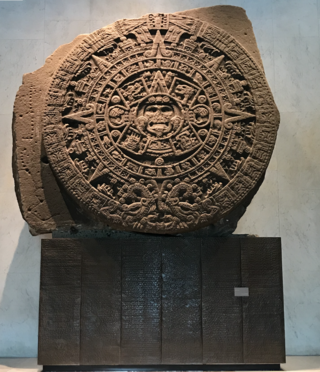
The Aztec or Mexica calendar is the calendrical system used by the Aztecs as well as other Pre-Columbian peoples of central Mexico. It is one of the Mesoamerican calendars, sharing the basic structure of calendars from throughout ancient Mesoamerica.

Tamoanchan[tamoˈant͡ʃan] is a mythical location of origin known to the Mesoamerican cultures of the central Mexican region in the Late Postclassic period. In the mythological traditions and creation accounts of Late Postclassic peoples such as the Aztec, Tamoanchan was conceived as a paradise where the gods created the first of the present human race out of sacrificed blood and ground human bones which had been stolen from the Underworld of Mictlan.
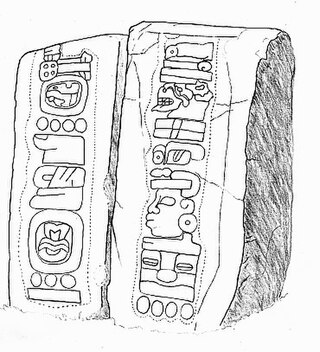
The calendrical systems devised and used by the pre-Columbian cultures of Mesoamerica, primarily a 260-day year, were used in religious observances and social rituals, such as divination.
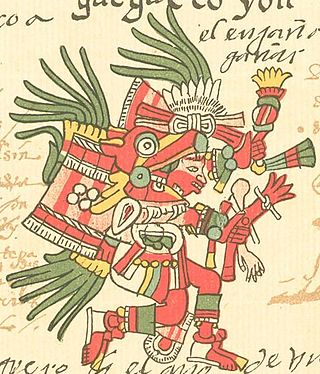
In Aztec mythology, Huehuecóyotl[weːweˈkojoːt͡ɬ] is the auspicious Pre-Columbian god of music, dance, mischief, and song. He is the patron of uninhibited sexuality and rules over the day sign in the Aztec calendar named cuetzpallin (lizard) and the fourth trecena Xochitl.

The tōnalpōhualli, meaning "count of days" in Nahuatl, is a Mexica version of the 260-day calendar in use in pre-Columbian Mesoamerica. This calendar is solar and consists of 20 13-day periods. Each trecena is ruled by a different deity. Graphic representations for the twenty day names have existed among certain ethnic, linguistic, or archaeologically identified peoples.

A trecena is a 13-day period used in pre-Columbian Mesoamerican calendars. The 260-day calendar was divided into 20 trecenas. Trecena is derived from the Spanish chroniclers and translates to "a group of thirteen" in the same way that a dozen relates to the number twelve. It is associated with the Aztecs, but is called different names in the calendars of the Maya, Zapotec, Mixtec, and others of the region.
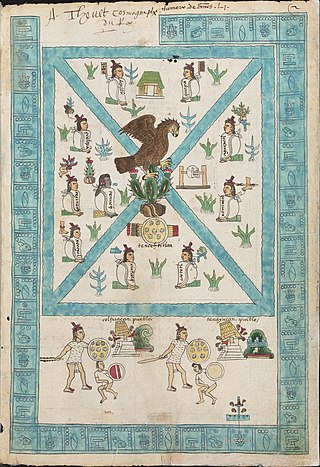
Aztec codices are Mesoamerican manuscripts made by the pre-Columbian Aztec, and their Nahuatl-speaking descendants during the colonial period in Mexico.
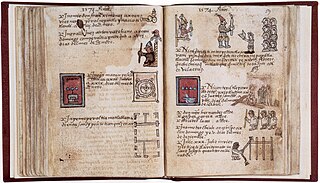
The Aubin Codex is an 81-leaf Aztec codex written in alphabetic Nahuatl on paper from Europe. Its textual and pictorial contents represent the history of the Aztec peoples who fled Aztlán, lived during the Spanish conquest of the Aztec Empire, and into the early Spanish colonial period, ending in 1608.

The Codex Magliabechiano is a pictorial Aztec codex created during the mid-16th century, in the early Spanish colonial period. It is representative of a set of codices known collectively as the Magliabechiano Group. The Codex Magliabechiano is based on an earlier unknown codex, which is assumed to have been the prototype for the Magliabechiano Group. It is named after Antonio Magliabechi, a 17th-century Italian manuscript collector, and is held in the Biblioteca Nazionale Centrale, Florence, Italy.

Codex Ríos is an Italian translation and augmentation of a Spanish colonial-era manuscript, Codex Telleriano-Remensis, that is partially attributed to Pedro de los Ríos, a Dominican friar working in Oaxaca and Puebla between 1547 and 1562. The codex itself was likely written and drawn in Italy after 1566.

The Codex Borbonicus is an Aztec codex written by Aztec priests shortly before or after the Spanish conquest of the Aztec Empire. It is named after the Palais Bourbon in France and kept at the Bibliothèque de l'Assemblée Nationale in Paris. The codex is an outstanding example of how Aztec manuscript painting is crucial for the understanding of Mexica calendric constructions, deities, and ritual actions.

The tonalamatl[toːnaˈlaːmatɬ] is a divinatory almanac used in central Mexico in the decades, and perhaps centuries, leading up to the Spanish conquest. The word itself is Nahuatl in origin, meaning "pages of days".

The Codex Borgia, also known as Codex Borgianus, Manuscrit de Veletri and Codex Yohualli Ehecatl, is a pre-Columbian Middle American pictorial manuscript from Central Mexico featuring calendrical and ritual content, dating from the 16th century. It is named after the 18th century Italian Cardinal, Stefano Borgia, who owned it before it was acquired by the Vatican Library after the Cardinal's death in 1804.

Codex Boturini, also known as the Tira de la Peregrinación de los Mexica, is an Aztec codex, which depicts the migration of the Azteca, later Mexica, people from Aztlán. Its date of manufacture is unknown, but likely to have occurred before or just after the Conquest of the Aztec Empire. At least two other Aztec codices have been influenced by the content and style of the Boturini Codex. This Codex has become an insignia of Mexica history and pilgrimage and is carved into a stone wall at the entrance of the National Museum of Anthropology and History in Mexico City.

The Codex Fejérváry-Mayer is an Aztec Codex of central Mexico. It is one of the rare pre-Hispanic manuscripts that have survived the Spanish conquest of Mexico. As a typical calendar codex tonalamatl dealing with the sacred Aztec calendar – the tonalpohualli – it is placed in the Borgia Group. It is a divinatory almanac in 17 sections. Its elaboration is typically pre-Columbian: it is made on deerskin parchment folded accordion-style into 23 pages. It measures 16.2 centimetres by 17.2 centimetres and is 3.85 metres long.
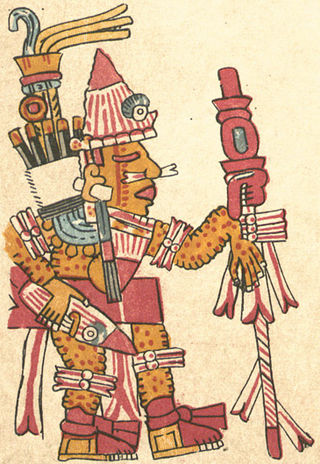
In Aztec religion, Itztapaltotec is an aspect of the fertility god Xipe Totec. In the Aztec calendar, he is one of the patrons of the trecena beginning with the day One Rabbit, alongside Xiuhtecuhtli, the god of fire. Xipe Totec proper is the patron of the trecena beginning with the day One Dog. Itztapaltotec is an obscure figure, known only from tonalamatl (calendars). Brief, confusing information about him is given in two related manuscripts, the Codex Telleriano-Remensis and the Codex Ríos.
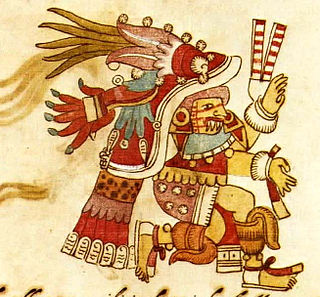
In Aztec religion, Chantico is the deity reigning over the fires in the family hearth. She broke a fast by eating paprika with roasted fish, and was turned into a dog by Tonacatecuhtli as punishment. She was associated with the town of Xochimilco, stonecutters, as well as warriorship. Chantico was described in various Pre-Columbian and colonial codices.

Codex Vaticanus B, also known as Codex Vaticanus 3773, Codice Vaticano Rituale, and Códice Fábrega, is a pre-Columbian Middle American pictorial manuscript, probably from the Puebla part of the Mixtec region, with a ritual and calendrical content. It is a member of the Borgia Group of manuscripts. It is currently housed at the Vatican Library.

The Codex Ixtlilxochitl is a pictorial Aztec Codex created between 1580 and 1584, after the arrival of the Conquistadors and during the early Spanish colonial period. It is a record of the past ceremonies and holidays observed at the Great Teocalli of the Aztec city of Texcoco, near modern-day Mexico City, and contains visual representations of rulers and deities with association to Texcoco. The existence of this codex is a demonstration of the cultural assimilations and interactions between native Aztecs, Spanish colonists, and mestizos that occurred during the 17th century in Mexico as the colonies developed and their residents, of all cultures, endeavored to find a balance between native tradition and colonial innovation. Contrasting with the attitude of colonists from the prior century of striving for a complete annihilation of all native culture, this codex served as a quasi-translator between native and European cultural languages, and denotes an occurrence of European fascination with the unknown resulting in a valuable preservation of the native cultures they had previously sought to destroy.




















